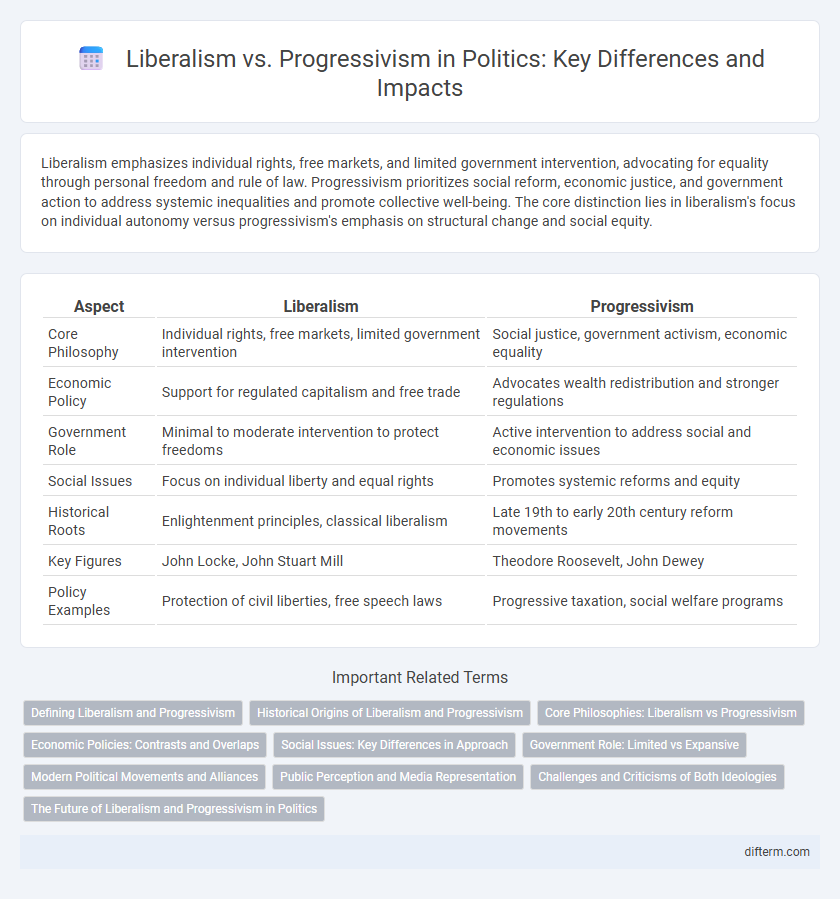Liberalism emphasizes individual rights, free markets, and limited government intervention, advocating for equality through personal freedom and rule of law. Progressivism prioritizes social reform, economic justice, and government action to address systemic inequalities and promote collective well-being. The core distinction lies in liberalism's focus on individual autonomy versus progressivism's emphasis on structural change and social equity.
Table of Comparison
| Aspect | Liberalism | Progressivism |
|---|---|---|
| Core Philosophy | Individual rights, free markets, limited government intervention | Social justice, government activism, economic equality |
| Economic Policy | Support for regulated capitalism and free trade | Advocates wealth redistribution and stronger regulations |
| Government Role | Minimal to moderate intervention to protect freedoms | Active intervention to address social and economic issues |
| Social Issues | Focus on individual liberty and equal rights | Promotes systemic reforms and equity |
| Historical Roots | Enlightenment principles, classical liberalism | Late 19th to early 20th century reform movements |
| Key Figures | John Locke, John Stuart Mill | Theodore Roosevelt, John Dewey |
| Policy Examples | Protection of civil liberties, free speech laws | Progressive taxation, social welfare programs |
Defining Liberalism and Progressivism
Liberalism advocates for individual freedoms, limited government intervention, and free-market principles to promote equality and personal rights. Progressivism emphasizes social reform, government action, and policies aimed at reducing economic inequality and addressing systemic injustices. Both ideologies share a commitment to improving society but differ in their approaches to the role of government and social change.
Historical Origins of Liberalism and Progressivism
Liberalism originated in the 17th and 18th centuries during the Enlightenment, emphasizing individual rights, limited government, and free markets as seen in the works of John Locke and Adam Smith. Progressivism emerged in the late 19th and early 20th centuries as a response to industrialization and social inequalities, focusing on government intervention, social reforms, and economic regulation. Key figures like Theodore Roosevelt and Woodrow Wilson championed progressivism to address issues such as labor rights, monopoly control, and public health.
Core Philosophies: Liberalism vs Progressivism
Liberalism emphasizes individual rights, limited government intervention, and free-market principles as foundations for personal freedom and economic prosperity. Progressivism advocates for active government involvement to address social inequalities, promote social justice, and implement reforms that advance collective well-being. The core philosophical divide centers on the balance between personal liberty and the pursuit of social equity through systemic change.
Economic Policies: Contrasts and Overlaps
Liberalism emphasizes free markets with measured government intervention aimed at ensuring economic efficiency and individual property rights, while progressivism advocates for more robust regulatory measures to address income inequality and social justice through wealth redistribution and social welfare programs. Both ideologies support capitalism but diverge on the scope and scale of state involvement in economic affairs, with progressivism favoring expansive fiscal policies and liberalism promoting limited government roles. The overlap lies in their commitment to democratic governance and human rights, yet their economic policy prescriptions differ significantly in prioritizing market freedom versus social equity.
Social Issues: Key Differences in Approach
Liberalism emphasizes individual rights and equal opportunities, advocating for gradual reform within existing political frameworks to address social issues such as freedom of speech and civil liberties. Progressivism prioritizes systemic change and social justice, often supporting more proactive government intervention to combat inequality and promote policies like affirmative action and expanded social welfare. The key difference lies in liberals seeking balance through incremental progress, while progressives push for transformative shifts to achieve social equity.
Government Role: Limited vs Expansive
Liberalism advocates for a limited government role, emphasizing individual freedoms and free markets to drive societal progress. Progressivism supports an expansive government role, promoting regulatory policies and social programs to address inequality and protect public welfare. These contrasting views shape policy debates on taxation, healthcare, and civil rights.
Modern Political Movements and Alliances
Modern political movements distinguish liberalism by its emphasis on individual rights, free markets, and limited government intervention, whereas progressivism prioritizes social justice, economic equality, and proactive government policies. Alliances in contemporary politics reveal liberals often supporting centrist or moderate parties, while progressives align with left-wing coalitions advocating transformative reforms. These differing priorities shape legislative agendas, electoral strategies, and policy outcomes within democratic systems.
Public Perception and Media Representation
Public perception of liberalism often centers on individual freedoms and free-market principles, while progressivism is frequently associated with social justice and systemic reform. Media representation tends to frame liberals as proponents of moderate change, contrasting with progressives who are portrayed as advocating more radical policy shifts. This dichotomy influences public discourse, shaping voter attitudes and political alignment in contemporary elections.
Challenges and Criticisms of Both Ideologies
Liberalism faces challenges related to its emphasis on individual rights, which critics argue can overlook systemic inequalities and social justice concerns, limiting its effectiveness in addressing structural problems. Progressivism encounters criticism for its support of expansive government intervention, which opponents claim may undermine personal freedoms and lead to bureaucratic overreach. Both ideologies grapple with balancing equality and liberty, often facing polarization in political discourse that hampers consensus-building and policy implementation.
The Future of Liberalism and Progressivism in Politics
The future of liberalism and progressivism in politics hinges on their ability to address rising economic inequality and climate change while adapting to digital transformation and social justice movements. Progressive policies increasingly emphasize systemic reform through expanded social safety nets, environmental sustainability, and inclusive governance, contrasting with liberalism's traditional focus on individual rights and market-based solutions. Both ideologies face challenges in coalition-building and voter engagement as political landscapes shift amid global geopolitical tensions and cultural polarization.
liberalism vs progressivism Infographic

 difterm.com
difterm.com